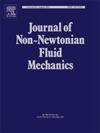Simulation of the extensional deformation of a drop with an elastoviscoplastic interface
IF 2.7
2区 工程技术
Q2 MECHANICS
引用次数: 0
Abstract
A numerical implementation of two-phase flows of Newtonian fluids with a non-linear viscoelastic interface is validated and applied to the case of uniaxial extension of a drop in a matrix fluid. Second-order convergence in space and time is obtained with a Lagrangian-based interface tracking finite element method. The flow problem is analysed using dimensionless groups based on the relative magnitudes of the viscoelastic interfacial extra stress, the interfacial tension and the viscous stress of the bulk fluids. After fitting the intrinsic viscoelastic stress–strain behaviour of interfaces in shear to experimental results from the literature, the influence of interfacial rheology on the drop shape and interfacial stress is investigated. The drop shape is not significantly influenced by the viscoelastic properties of the interface if the interfacial viscoelastic stress, interfacial tension and bulk viscous stress are of the same order of magnitude. However, the interface develops distinct stress profiles for varying interfacial viscoelastic properties. For relatively large viscoelastic interface stress compared to interfacial tension and bulk viscous stress, simulations become unstable. Eventually, the interfacial viscoelastic stress exceeds the interfacial tension and bulk viscous stress, and possibly buckling of the interface occurs, caused by compressive stresses at the drop tip.

弹粘塑性界面液滴拉伸变形的模拟
验证了具有非线性粘弹性界面的牛顿流体两相流动的数值实现,并将其应用于液滴在基质流体中单轴扩展的情况。利用基于拉格朗日的界面跟踪有限元方法,得到了空间和时间上的二阶收敛性。根据粘弹性界面额外应力、界面张力和黏性应力的相对大小,采用无量纲群对流动问题进行了分析。将剪切界面的粘弹性应力-应变特性与文献实验结果拟合后,研究了界面流变对液滴形状和界面应力的影响。当界面粘弹性应力、界面张力和体粘应力处于同一数量级时,液滴形态不受界面粘弹性特性的显著影响。然而,由于界面粘弹性的不同,界面产生了不同的应力分布。对于相对较大的粘弹性界面应力,与界面张力和体粘性应力相比,模拟变得不稳定。最终,界面粘弹性应力超过界面张力和体粘性应力,并可能发生界面屈曲,这是由水滴尖端的压应力引起的。
本文章由计算机程序翻译,如有差异,请以英文原文为准。
求助全文
约1分钟内获得全文
求助全文
来源期刊
CiteScore
5.00
自引率
19.40%
发文量
109
审稿时长
61 days
期刊介绍:
The Journal of Non-Newtonian Fluid Mechanics publishes research on flowing soft matter systems. Submissions in all areas of flowing complex fluids are welcomed, including polymer melts and solutions, suspensions, colloids, surfactant solutions, biological fluids, gels, liquid crystals and granular materials. Flow problems relevant to microfluidics, lab-on-a-chip, nanofluidics, biological flows, geophysical flows, industrial processes and other applications are of interest.
Subjects considered suitable for the journal include the following (not necessarily in order of importance):
Theoretical, computational and experimental studies of naturally or technologically relevant flow problems where the non-Newtonian nature of the fluid is important in determining the character of the flow. We seek in particular studies that lend mechanistic insight into flow behavior in complex fluids or highlight flow phenomena unique to complex fluids. Examples include
Instabilities, unsteady and turbulent or chaotic flow characteristics in non-Newtonian fluids,
Multiphase flows involving complex fluids,
Problems involving transport phenomena such as heat and mass transfer and mixing, to the extent that the non-Newtonian flow behavior is central to the transport phenomena,
Novel flow situations that suggest the need for further theoretical study,
Practical situations of flow that are in need of systematic theoretical and experimental research. Such issues and developments commonly arise, for example, in the polymer processing, petroleum, pharmaceutical, biomedical and consumer product industries.

 求助内容:
求助内容: 应助结果提醒方式:
应助结果提醒方式:


